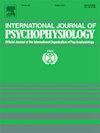基于脑电特征和机器学习的社交焦虑神经机制分析及诊断模型构建
IF 2.5
3区 心理学
Q3 NEUROSCIENCES
引用次数: 0
摘要
社交焦虑是一种常见的心理问题,其准确诊断和探讨潜在的神经生理机制具有重要意义。本研究旨在通过整合事件相关电位(ERP)、事件相关谱摄动(ERSP)和机器学习等方法,探讨社交焦虑的神经电生理特征及其诊断价值。共有128名具有不同程度社交焦虑的参与者完成了一项情绪脸Go/No-Go任务,在此过程中,脑电图(EEG)数据被收集用于ERP和时频分析。结果表明,社交焦虑个体在从早期感知到后期调节的整个过程中都表现出异常:在早期加工阶段,观察到高警觉性(增强N1)、冲突监测缺陷(异常N2潜伏期)和情绪评估偏差(平坦P2)的迹象,并伴有δ / θ频段同步增加。在调节后期,表现为分类功能紊乱(P3逆转)、情绪维持无效(LPP调节缺失)、代偿性注意资源过度募集(α / β去同步化增强)。这些脑电图指标被发现与社交焦虑症状广泛相关。基于所选特征构建的支持向量机(SVM)模型在原始数据集上表现优异(准确率88.462%,AUC 90.1966%),在独立验证数据集(n = 38)上保持良好的泛化性能,准确率为68.421%,AUC为80.000%。本研究为早期社交焦虑的客观诊断和探索其神经生理机制提供了新的见解,同时也为针对性干预策略的制定指明了方向。未来的研究应进一步扩大样本量,提高生态效度,探索个性化预测和神经调节的潜力。本文章由计算机程序翻译,如有差异,请以英文原文为准。
Analysis of the neural mechanisms of social anxiety based on EEG features and machine learning and construction of a diagnostic model
Social anxiety is a common psychological problem, and its accurate diagnosis and investigation of underlying neurophysiological mechanisms are of significant importance. This study aims to explore the neuroelectrophysiological characteristics and diagnostic value of social anxiety by integrating event-related potentials (ERP), event-related spectral perturbation (ERSP), and machine learning methods. A total of 128 participants with varying levels of social anxiety completed an emotional face Go/No-Go task, during which electroencephalographic (EEG) data were collected for ERP and time-frequency analyses. The results revealed that individuals with social anxiety exhibited abnormalities throughout the entire process, from early perception to late regulation: during the early processing stage, signs of hypervigilance (enhanced N1), deficits in conflict monitoring (abnormal N2 latency), and biases in emotional evaluation (flattened P2) were observed, accompanied by increased synchronization in the delta/theta frequency bands. In the late regulation stage, there were signs of disorganized classification functions (reversed P3), ineffective emotional maintenance (absence of LPP regulation), and excessive recruitment of compensatory attentional resources (enhanced alpha/beta desynchronization). These EEG indicators were found to be broadly correlated with symptoms of social anxiety. The support vector machine (SVM) model constructed from the selected features demonstrated excellent performance on the original dataset (accuracy 88.462 %, AUC 90.196 %) and maintained good generalization performance on an independent validation dataset (n = 38), achieving an accuracy of 68.421 % and an AUC of 80.000 %. This study provides new insights for the objective diagnosis of early social anxiety and the exploration of its neurophysiological mechanisms, while also indicating directions for the development of targeted intervention strategies. Future research should further expand the sample size, enhance ecological validity, and explore the potential for individualized prediction and neural modulation.
求助全文
通过发布文献求助,成功后即可免费获取论文全文。
去求助
来源期刊
CiteScore
5.40
自引率
10.00%
发文量
177
审稿时长
3-8 weeks
期刊介绍:
The International Journal of Psychophysiology is the official journal of the International Organization of Psychophysiology, and provides a respected forum for the publication of high quality original contributions on all aspects of psychophysiology. The journal is interdisciplinary and aims to integrate the neurosciences and behavioral sciences. Empirical, theoretical, and review articles are encouraged in the following areas:
• Cerebral psychophysiology: including functional brain mapping and neuroimaging with Event-Related Potentials (ERPs), Positron Emission Tomography (PET), Functional Magnetic Resonance Imaging (fMRI) and Electroencephalographic studies.
• Autonomic functions: including bilateral electrodermal activity, pupillometry and blood volume changes.
• Cardiovascular Psychophysiology:including studies of blood pressure, cardiac functioning and respiration.
• Somatic psychophysiology: including muscle activity, eye movements and eye blinks.

 求助内容:
求助内容: 应助结果提醒方式:
应助结果提醒方式:


